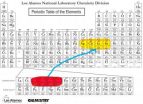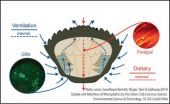Yale researchers identify targets for immunotherapy in early-stage breast cancer
2014-07-18
(Press-News.org) July 17, 2014, New Haven, CT – Yale Cancer Center researchers used a new molecular analysis tool to accurately detect the level of an important target for immunotherapy in early-stage breast cancers. The diagnostic test, using RNAScope, measures the amount of PD-L1 (programmed death ligand 1) mRNA in routine formalin-fixed cancer tissues and is devoid of many of the technical issues that plague antibody-based detection methods that have yielded conflicting results in the past. PD-L1 is the target of several novel immune stimulatory therapies in clinical trials. The findings were published in the Journal of Clinical Cancer Research in May.
PD-L1 is a protein that plays an important role in suppressing immune response, and in cancer, it may allow tumors to evade immune attack. The study demonstrated that about 60 percent of early-stage breast cancers have PD-L1 expression, and a subset of these cancers also have large numbers of tumor infiltrating lymphocytes. High levels of lymphocytes and PD-L1 predicted for better survival, suggesting a beneficial role for the immune system in at least partially controlling these cancers.
"This is exciting because these findings provide the rationale to test PD-L1 targeted therapies in breast cancer with the hope of further improving cure rates in early stage breast cancer," said Lajos Pusztai, MD, DPhil, professor of Medical Oncology and chief of Breast Medical Oncology at Smilow Cancer Hospital, Yale Cancer Center, and an author on the study. "Patients with many tumor infiltrating lymphocytes and high PD-L1 expression may be the ideal candidates for these therapies."
The in situ mRNA detection method used in the study, eliminates many of the technical problems that older immunohistochemistry assays had, Pusztai added.
INFORMATION:
Senior author on the study was David L. Rimm, MD, PhD; co-authors were Kurt A. Schalper, MD, PhD; Daniel Carvahal, MD; Halle Wimberly, PhD candidate; Jason Brown, MD-, PhD candidate; all of Yale; and Vamisdhar Vecheti, MD, of Cleveland Clinic.
ELSE PRESS RELEASES FROM THIS DATE:
Interleukin-10 aids survival of cells transplanted to repair cardiac tissues after MI
2014-07-18
Putnam Valley, NY. (July 18th 2014) – The long-term, positive benefits of transplanted allogenic (other-donated) smooth muscle cells (SMCs) to repair cardiac tissues after myocardial infarction (MI) have been enhanced by the addition of interleukin 10 (IL-10) to the transplanted cells, report researchers in Canada. Their study with rats modeled with MI has shown that SMCs modified with IL-10 - a small, anti-inflammatory protein - benefitted cell survival, improved heart function, and also provided protection against the host's rejection of the allogenic SMCs.
The study ...
Highly charged ions
2014-07-18
The world is mostly neutral. That is, most of the atoms in our environment are electrically neutral. The number of electrons in the outer parts of atoms equals the number of protons at the centers of atoms. As one or more electrons are plucked away from the atoms, the remaining electrons feel a much stronger positive pull from the nucleus. This enhanced pull, causing the atoms to shrink in size, ensures that those electrons are less vulnerable to the distractions of their environment, making them potentially valuable for next-generation atomic clocks, for quantum information ...
Economic development not the only influence on personal car use, study finds
2014-07-18
Although countries with high levels of economic development generally have more personal automobile travel than less-affluent nations, income is not the only factor that determines a nation's demand for cars, according to a new study.
Examining factors that may influence personal automobile use in developing nations, researchers found that government policies such as taxes that keep fuel costs high and the development of road systems can have important influence on levels of automobile travel.
Shaping the personal use of automobiles is an important issue in developing ...
UM-led research team contributes to the management of South Florida coastal environments
2014-07-18
MIAMI – A Florida-based marine research team has developed a unique formal process and modeling framework to help manage South Florida's economically important coastal marine environments. The MARES project (Marine and Estuarine Goal Setting), led by the National Oceanic and Atmospheric Administration's (NOAA) Cooperative Institute for Marine and Atmospheric Studies (CIMAS) based at the University of Miami (UM) Rosenstiel School of Marine and Atmospheric Science, successfully integrated both ecosystem science and societal benefits into a marine ecosystem support tool to ...
Scientists find new clues to brain's wiring
2014-07-18
New research provides an intriguing glimpse into the processes that establish connections between nerve cells in the brain. These connections, or synapses, allow nerve cells to transmit and process information involved in thinking and moving the body.
Reporting online in Neuron, researchers at Washington University School of Medicine in St. Louis have identified a group of proteins that program a common type of brain nerve cell to connect with another type of nerve cell in the brain.
The finding is an important step forward in efforts to learn how the developing brain ...
Measuring the number of protein molecules inside cells
2014-07-18
This news release is available in Portuguese. This news release is available in Portuguese.
The identification of the genes and proteins involved in a biological process, as well as the way they interact, are essential for the understanding of that process. However, often little is known about the dimensions of molecular biological structures. Knowing how many molecules make up a structure and are required for its function are essential for our understanding of biological mechanisms. Yet, quantifying molecules of infinitesimal size poses a difficult challenge. ...
Revealed: The mystery behind starling flocks
2014-07-18
The mystery behind the movements of flocking starlings could be explained by the areas of light and dark created as they fly, new research suggests.
The research, conducted by the University of Warwick and published in the journal PNAS, found that flocking starlings aim to maintain an optimum density at which they can gather data on their surroundings. This occurs when they can see light through the flock at many angles, a state known as marginal opacity. The subsequent pattern of light and dark, formed as the birds attempt to achieve the necessary density, is what provides ...
Adults with eosinophilic esophagitis should consider a diet change
2014-07-18
Bethesda, MD (July 18, 2014) — Dietary elimination is a successful method of treatment for adults with eosinophilic esophagitis (EoE), according to a new study1 in Clinical Gastroenterology and Hepatology, the official clinical practice journal of the American Gastroenterological Association.
"By eliminating specific foods from patients' diets, symptoms improved in 71 percent of patients, and endoscopic appearance improved in 54 percent," said lead study author, W. Asher Wolf, MD, MPH, and co-author Evan S. Dellon, MD, MPH, from the division of gastroenterology and hepatology, ...
Genetic variations may modify cardiovascular benefit of aspirin
2014-07-18
BOSTON – Aspirin is the gold standard for antiplatelet therapy and a daily low-dose aspirin is widely prescribed for the prevention of cardiovascular disease.
Now, a new study suggests that common genetic variation in the gene for catechol-O-methyltransferase (COMT) may modify the cardiovascular benefit of aspirin, and in some people, may confer slight harm. The findings, led by investigators at Beth Israel Deaconess Medical Center (BIDMC) and Brigham and Women's Hospital (BWH) appear online in the American Heart Association journal Arteriosclerosis, Thrombosis, and ...
Microplastics worse for crabs and other marine life than previously thought, study shows
2014-07-18
The tiny plastic particles polluting our seas are not only orally ingested by marine creatures, but also enter their systems through their gills, according to a new study led by the University of Exeter.
Scientists also discovered that when microplastics are drawn in through this method they take over six times longer to leave the body compared with standard digestion.
Lead author Dr Andrew Watts of the University of Exeter said: "Many studies on microplastics only consider ingestion as a route of uptake into animals. The results we have just published stress other ...




